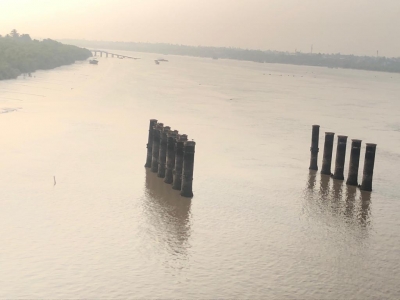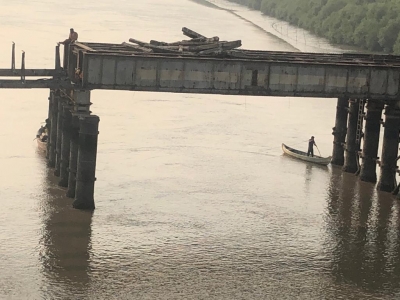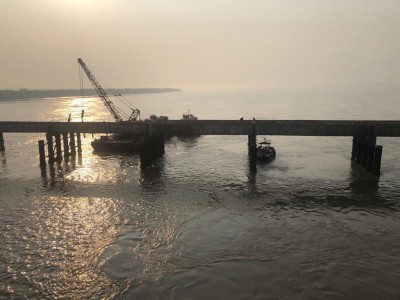

 By Quaid Najmi
By Quaid Najmi
Mumbai, Jan 1 : A slice of Indian Railways’ glorious heritage, in the form of two open bridges spanning two arms of the Thane Creek between Bhayander-Panju Isle and Panju Isle-Naigaon, are currently being dismantled at a frenetic pace, officials said here on Friday.
The two bridges, 156 years old, and totally 1,980 metres long, were constructed in 1864 – the same year as north India’s first railway station in the form of Delhi Junction was built to connect the national capital with the then Calcutta.
Constructed by the Bombay Baroda & Central India (BB&CI) Railway, bridge No 73 from Bhayander-Panju Isle (Thane district) is 1,430 metres long and the No 75 from Panju Isle-Naigaon (Palghar district) runs 550 metres. Both are 6 metres wide.
The first train on the then Backbay-Virar sector ran on April 12, 1867 – barely 14 years after the first historic railway line on the subcontinent started on April 16, 1853 between Bori Bunder-Thane.
The two strategic bridges served the Indian Railway on the crucial Mumbai-Delhi, and Mumbai-Ahmedabad routes on the modern-day WR for nearly 120 years.
In their heyday, these two gleaming bridges handled all Mumbai suburban trains from Churchgate to Virar, long-distance trains including passenger, express, mail and freight services, among them prestigious ones like Rajdhani Express, Frontier Mail, Jammu-Tawi Express, or Ahmedabad Passenger and other trains with many halts en route, besides heavily-laden good trains.
“The shorter bridge (No 73) was sold in February 2020, but due to lockdown, it could start the work of dismantling only from November 5. Nearly 80 percent of the dismantling work is now completed and more than half the scrap delivery is done,” WR Chief Spokesperson Sumit Thakur told IANS.
The work of dismantling the longer bridge (No 73) with gas cutters started on December 20, and nearly 35 percent progress has been achieved, he added.
As per current trends, the complete dismantling of the upper portions would be completed by January end, before the work on the pillars rooted in the Thane Creek waters is taken up.
For several decades, the two bridges were used by the people of the 2.50 square km vehicle-free Panju Isle, housing a population of around 1,500.
“We used to walk across these bridges to nearest railway stations, either Naigaon in north or Bhayander in south, to catch trains for onward destinations,” local areas tourism pioneer Kiran Bhoir told IANS.
He said that the bridges had ’emotional connect and were a reassuring sight’ for the Panju islanders, but now the scene is changing practically daily as the gas cutters tear them apart, huge cranes pick up the dismantled portions, leaving only the semi-rusted pillars pointing to the sky.
The northern end could take around 25 minutes and the southern end nearly 50 minutes of brisk walk, and it was also frequented when people missed boarding the last ferry commute from Naigaon to Panju Isle at night, and served as a tourist sight for people and the occasional journalists, Patil added.
According to some estimates, the WR could rake in nearly Rs 3 crore from the 1,450 tonnes scrap iron that would be generated from the bridges.
During the tenures of then Minister of State for Railways Ram Naik and later Railway Minister Lalu Prasad, there were demands to convert the two old rail-bridges to road-bridges for light vehicles which now have to take the long-winded Mumbai-Ahmedabad highway to reach the towns between Mira Road and Virar on the WR.
With the British-era bridges being snuffed out fast, WR officials indicate they may preserve certain heritage seals on the bridges at its gallery in Churchgate.
(Quaid Najmi can be contacted at q.najmi@ians.in)
Disclaimer: This story is auto-generated from IANS service.

